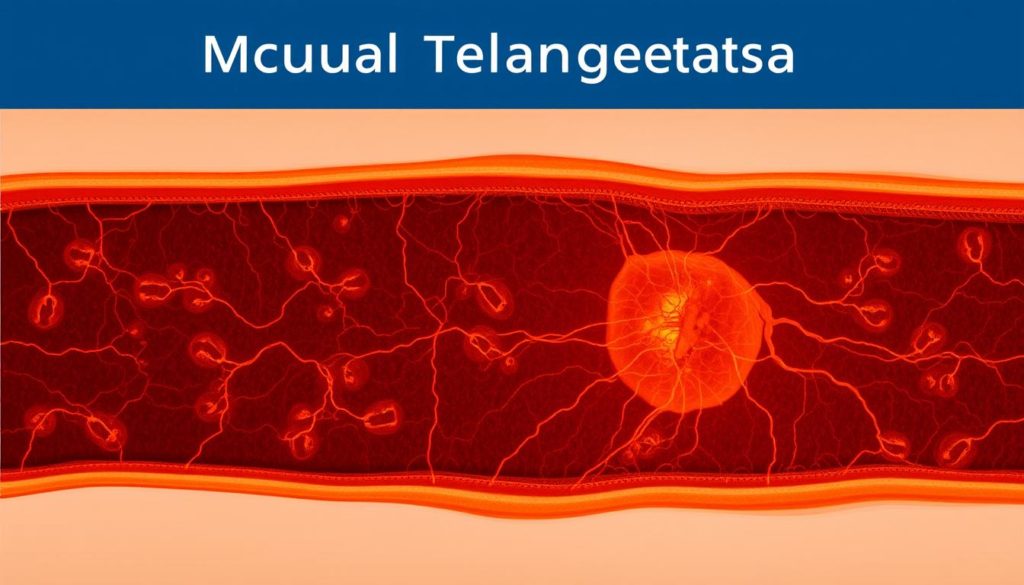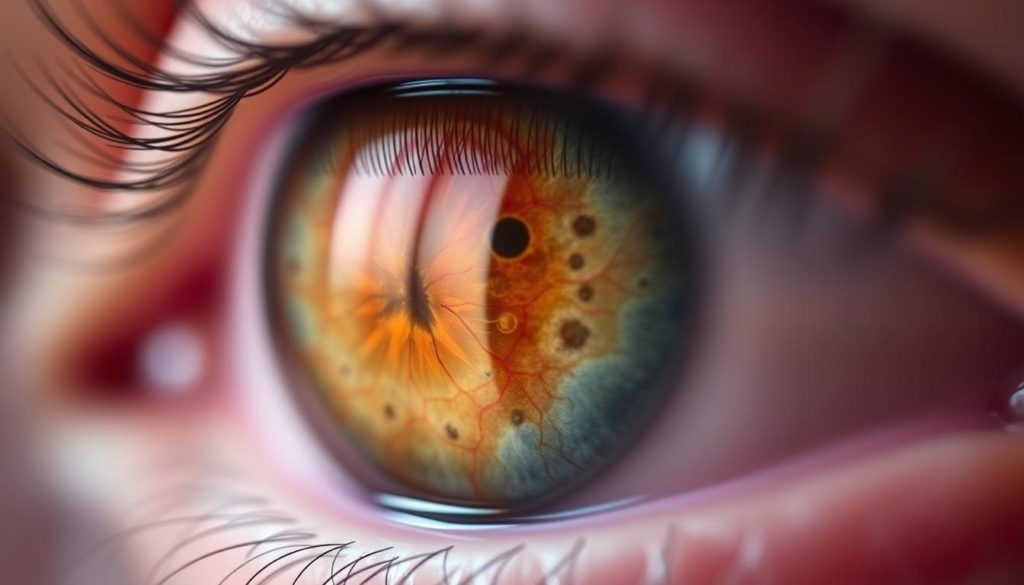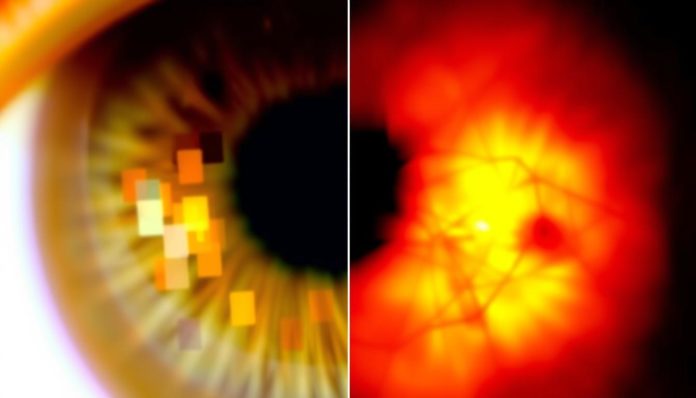Facing an eye disease like Macular Telangiectasia can be scary. It often starts with vision loss that sneaks up slowly. Knowing about this condition is crucial to deal with its effects. As the disease progresses, focusing on symptoms and treatment options can provide some light. This knowledge can help us find a way to manage and understand the uncertainties.
Learning about Macular Telangiectasia means taking control of a challenging journey. By paying close attention and taking action early, we can lead a life where vision loss doesn’t control everything. This guide is here to show the warning signs of Mac Tel. It also offers ways to deal with the eye disease. With the right information, we can face Macular Telangiectasia with courage. We aim for a world where people with central vision loss can still have hope.
What is Macular Telangiectasia?
Macular Telangiectasia, also called Mac Tel, is an eye disease that mainly hits the macula. The macula is the center part of the retina and is key for seeing details clearly. Slowly, this disease harms the eye’s blood vessels leading to loss of vision. Knowing about Mac Tel early is important for taking care of it.
The Basics of Mac Telangiectasia
Mac Tel happens when the macula’s tiny blood vessels start to fail. They can swell, leak, or scar, hurting our central vision badly. This condition usually affects both eyes, but it can hit them differently.
Types of Macular Telangiectasia
There are mainly two kinds of Mac Tel, each with its own features:
- Type 1 Mac Tel: This is the rarer type that usually hits just one eye. It shows up with clear aneurysms and blood vessel problems on one side of the macula.
- Type 2 Mac Tel: The more common type that affects both eyes. Unlike Type 1, it doesn’t show clear aneurysms but involves the loss of blood vessels near the macula’s center.
Understanding the types of Mac Tel is key to diagnosing and treating this eye disease correctly.
| Feature | Type 1 Mac Tel | Type 2 Mac Tel |
|---|---|---|
| Affected Eyes | Usually one eye | Both eyes |
| Visibility of Aneurysms | Prominent | None |
| Location of Vascular Abnormalities | Temporal side of the macula | Center of the macula |
| Commonality | Less common | More common |

Recognizing Symptoms of Macular Telangiectasia
Knowing the early symptoms of Macular Telangiectasia is key for quick help. We’ll look at the first signs and how symptoms change in people with this eye issue.
Early Warning Signs
The beginning of Macular Telangiectasia might not be obvious. Blurry vision in the center field is one early sign. It’s vital for reading and driving. Distorted vision is another, making straight lines look bent.
Colors might also seem duller. This affects how vibrant colors appear.
Progression of Symptoms
As the disease gets worse, symptoms are easier to notice. Losing central vision is a big problem. It makes it hard to see details right in front of you.

| Stage | Common Symptoms | Impact on Vision |
|---|---|---|
| Early | Blurred Vision, Distorted lines, Color distortion | Minimal but increasing difficulty in tasks requiring sharp central vision |
| Intermediate | Increased blurriness, More pronounced line distortion | Moderate, noticeable impact in central vision, challenges in facial recognition and detailed tasks |
| Advanced | Central Vision Loss, Dark spots in central vision | Severe, significant loss of central vision, legal blindness |
It’s crucial to know these symptoms if your vision changes. Finding and treating Macular Telangiectasia early can help save vision and life quality.
Exploring the Causes of Mac Telangiectasia
Understanding Macular Telangiectasia origins is key for finding treatments. We’re diving into leading theories and research to figure out this eye disease’s cause.
One main cause could be genetic links. Even though we don’t know the exact genes yet, macular disease history in families points to heredity.
Another interesting area is oxidative stress. It’s about how free radicals harm cells. Since these radicals damage retinal cells, they could play a big part in older adults getting this condition.
Abnormal retinal capillaries might also cause Mac Telangiectasia. These flaws can block normal blood flow. This leads to poor nutrition in the eye’s macular area, possibly starting the disease.
| Potential Cause | Explanation | Related Research |
|---|---|---|
| Genetic Factors | Family history of macular diseases suggesting a hereditary component. | Studies investigating the genetic sequences in affected families. |
| Oxidative Stress | Increased damage to retinal cells due to free radicals, especially in older adults. | Research linking antioxidant levels with the progression of macular diseases. |
| Capillary Abnormalities | Impairments in capillary structure leading to inadequate macular nutrition. | Ongoing clinical trials testing the efficacy of treatments aimed at improving capillary function. |
Learning more about these causes helps with early diagnosis and finding new treatments. It involves looking at Macular Telangiectasia through research and patient stories. Together, they help solve this complex issue.
Comparing Macular Telangiectasia and Macular Degeneration
Macular Telangiectasia and Macular Degeneration both harm the retina and mess with our vision. But, the way they hit us and how we fight them differs a lot. Knowing the difference is key for the right treatment.
Differences in Symptoms
Macular Telangiectasia messes with the retina’s blood vessels. This causes blurry vision and trouble with reading and seeing small details. On the other hand, Macular Degeneration, which more people know about, slowly makes it tough to see details right in front.
Differences in Prognosis and Treatment
The future outlook and treatment for these eye issues are very different. Each condition gets a unique treatment plan.
| Condition | Prognosis | Treatment Approaches |
|---|---|---|
| Macular Telangiectasia | Progressive condition with varying rates of progression; vision loss can be severe | Focused on stabilizing vision through laser therapy and injections to manage fluid accumulation |
| Macular Degeneration | Gradual worsening; often leads to significant central vision loss | Lifestyle adjustments, vitamin supplements, and advanced treatments like VEGF inhibitors to slow disease progression |
Diagnosing Macular Telangiectasia
Finding Macular Telangiectasia right is key to managing it well and keeping good vision. Advanced tools and the skill of an eye doctor are crucial in spotting and handling this condition. If not treated, it can make you lose much of your vision.
Tools and Tests for Detection
There are several advanced tools used to find Macular Telangiectasia. Optical Coherence Tomography (OCT) and Fluorescein Angiography are especially important. OCT shows detailed pictures of the retina. This helps eye doctors see its thickness and structure, which is important for diagnosis. Fluorescein Angiography lets doctors see how blood flows in the retina. It finds problems that could make you lose vision.
The Role of Ophthalmologists in Diagnostics
Eye doctors are very important in diagnosing this condition. They’re not just good at using tools. They also know how to read the results. This ensures the diagnosis is right and the treatment plan is made just for you. Seeing an eye doctor regularly helps track the condition. It also helps change treatments when needed to manage vision loss better.
Knowing how crucial timely and right diagnosis is can make a big difference in dealing with Macular Telangiectasia. Each tool and the eye doctor’s skill at reading them play a big part in keeping good vision and getting better outcomes for patients.
Risk Factors Associated with Macular Telangiectasia
Understanding Macular Telangiectasia risk factors is key to handling this retinal vascular disease. There are different areas to look into. These include genetic backgrounds, how old you are, and things in your environment.
The age of a person is a big risk factor. The older one gets, the more likely they are to have issues. So, it’s crucial for older people to have regular eye exams. Also, if your family has a history of eye diseases, you should keep a close eye on your vision.
- Genetic predisposition to eye diseases
- Increasing age and natural degradation of retinal health
- Exposure to environmental factors that can exacerbate eye health
| Age Group | Risk Level |
|---|---|
| 50-60 years | Moderate |
| 61 years and above | High |
Your lifestyle choices can also affect your risk. Things like poor diet, smoking, and not exercising enough can be harmful. They can worsen symptoms or increase the chance of getting the disease. So, changing these habits is important for your eye health.
Understanding the Impact of Macular Telangiectasia on Vision
Macular Disease, especially Macular Telangiectasia, deeply affects how we see. It changes everyday life in big ways. Central Vision Loss is one major problem. It makes it hard to see details and affects how people live. We’ll look at how this disease impacts vision and ways to adapt to vision loss.
Central Vision Loss and its Effects
Central Vision Loss happens when the middle part of the eye’s retina gets worse. This loss hurts our ability to see well. It leads to:
- Difficulty reading fine print or recognizing faces
- Challenges in distinguishing colors or sharp details
- Decreased sensitivity to subtle contrasts
This kind of vision loss changes how people interact with the world. Simple things like driving or using phones become much harder.
Adapting to Changes in Sight
To deal with vision changes, people use special strategies and tools. These things help in doing everyday tasks and living a better life. They include:
- Use of high-contrast and large-print books, labels, and devices
- Installation of adequate lighting to improve visibility in home and work environments
- Employment of magnifying tools for close-up tasks like reading or sewing
Also, getting help from professionals is key. They teach how to use other senses and the vision you have left.
Learning and using these methods helps people with Macular Disease. It lets them manage better despite the problems from Central Vision Loss. This journey needs both physical changes and strong willpower. It’s about finding ways to overcome challenges of not seeing well.
Treatment Options for Macular Telangiectasia
Treating Macular Telangiectasia means using different methods to help symptoms and slow the disease. We’ll look at two main treatments: medicine and laser therapy. Both play a key role in handling this eye condition.
Medications and Injections
Doctors often use anti-VEGF injections to stop the growth of abnormal blood vessels. Given right into the eye, these shots can keep vision steady or even make it better. How often and how long you get them depends on how you react and how bad your condition is.
Laser Therapy and its Efficacy
Laser Therapy is important for treating this disease. It uses a laser beam to close off leaking blood vessels that harm the retina. Thanks to new laser tech, this treatment is safer and more accurate than before.
But, doctors need to be careful. The laser’s power can sometimes cause problems like burns on the retina. Scientists are always looking to make this treatment better and safer.
The strategy for treating this eye condition combines medicine and laser therapy. This mix offers hope and a chance for a better quality of life. The best treatment plan depends on the patient’s unique situation. So, it’s crucial to work with a healthcare provider to choose the right approach.
Lifestyle Adjustments for Living with Mac Telangiectasia
Having Macular Telangiectasia means making smart Lifestyle Adjustments. You’ll also need Visual Aids. Learning to adapt is crucial for a good life. Let’s look at how diet and assistive tech can help you stay active and independent.
Diet and Nutrition
Your diet is very important in handling Macular Telangiectasia. You need vitamins A, C, E, and zinc for your eyes. Eating lots of fruits, veggies, and fish rich in omega-3 is great for your eye’s health.
Visual Aids and Assistive Devices
If you’re losing vision, there are many Visual Aids to help. Things like magnifiers, special glasses, and big-text books can simplify daily tasks. Tech like reading software and speech controls boosts your independence too.
- Magnifying devices
- Specialized computer screens and software programs
- Voice-activated home assistants
The Role of Research in Macular Telangiectasia
Research on Macular Telangiectasia is changing how we see this Retinal Vascular Disease. It sheds light on its causes and possible treatments. This gives new hope to those affected.
Over the last ten years, studies have grown. They explore genetics, how our environment affects us, and new treatments. Finding specific treatments to relieve symptoms or stop the disease’s progress is the goal.
- In-depth genetic analysis
- Investigation of environmental impact factors
- Development and trial of novel pharmacological treatments
In the words of leading researchers, “Every new discovery in Macular Telangiectasia provides a crucial piece of the puzzle in combating this debilitating disease.”
Identifying biomarkers for the disease’s progression is exciting. It means treatments can be tailored and started earlier. This approach shows the complexity of treating this condition.
| Focus Area | Description | Impact on Treatment |
|---|---|---|
| Genetic Research | Identifying genes linked to disease onset | Improved diagnostic accuracy |
| Pharmacological Advances | Developing drugs targeting disease-specific pathways | Potential for halting disease progression |
| Lifestyle and Dietary Studies | Assessing the effects of diet on disease progression | Guidance on preventive care strategies |
Efforts in Macular Telangiectasia Research aim to enhance patients’ lives. They also look to overcome the challenges of this Retinal Vascular Disease. Supporting and funding research is vital for future breakthroughs.
Macular Telangiectasia: Managing Emotional and Social Impact
When you have Macular Telangiectasia, you face emotional and social challenges. The support from the community and healthcare is crucial. It helps manage the Emotional Impact and Social Impact of the disease. Finding Support Systems and joining Macular Telangiectasia Support groups are key for patients and families.
Support Systems and Counseling
Counseling is a lifeline for those with Macular Telangiectasia. Therapists understand the mental effects of long-term illnesses. They help with isolation and frustration. Also, counseling for families makes the home more supportive.
Connecting with Others Living with Retinal Vascular Diseases
It’s important to connect with others who understand. Support groups, online or face-to-face, let people share experiences. They ensure you’re not alone in this.
Support groups organize activities that matter. Here’s what they typically do:
| Activity | Purpose | Frequency |
|---|---|---|
| Group Meetings | Discussion and community bonding | Monthly |
| Guest Speakers | Educational enrichment | Quarterly |
| Workshops | Skill enhancement | Semi-annually |
| Social Outings | Recreational interaction | Bi-annually |
This table shows the value of group activities. They help establish routines that improve social and emotional health. Being active in these groups helps people feel part of the community and better manage their condition.
Future Directions in the Care for Macular Telangiectasia
The journey to improve care for Macular Telangiectasia never stops. Researchers and doctors are always making progress. With new technology, there’s real hope for advanced treatments and tools. The growth of genetic medicine and stem cell therapy is exciting. It promises personalized treatments that better fit individual needs.
There’s also a focus on preventing the disease and catching it early. Finding the disease early can help stop vision loss. New imaging technology is making headlines too. It could lead to better ways to watch how the disease progresses. This lets eye doctors customize care for each person, which is very important.
The future for people with Macular Telangiectasia is getting brighter. New drugs and regenerative medicine are just the start. Many scientists from different fields are working together. Their goal is to improve life for those with this eye disease and to find a cure. This teamwork keeps hope alive for patients and doctors alike.
FAQ
What are the early warning signs of Macular Telangiectasia?
If you notice your vision is blurry or warped, it could be a sign. Having trouble seeing small details or changes in the center of your vision are also signs.
How does Macular Telangiectasia differ from Macular Degeneration?
Macular Telangiectasia involves swelling and leaky blood vessels in the macula. On the other hand, Macular Degeneration generally means the macula is getting worse, often because of aging or small deposits.
What tests are used to diagnose Macular Telangiectasia?
Doctors use imaging tests like OCT and fluorescein angiography to diagnose. These tests give a clear view of the retina and can spot abnormal vessels.
Can lifestyle changes impact the progression of Macular Telangiectasia?
Though it’s not fully understood, a healthy diet, eye protection from UV light, and no smoking might help.
Are there treatments available for Macular Telangiectasia?
Treatments could be anti-VEGF injections to slow disease progression or laser therapy for blood vessel leaks. The success of treatments varies, so continued research is vital.
What can I do to manage the effects of vision loss due to Macular Telangiectasia?
Using low-vision aids and vision rehabilitation helps in adjusting to vision loss. Also, modifying your home can enhance safety and use remaining vision better.
How can I connect with others dealing with Macular Telangiectasia?
Support groups, online communities, or networks for retinal diseases provide comfort and share experiences from those living with it.
What ongoing research is being done on Macular Telangiectasia?
Researchers are looking into the genetic and molecular causes of Mac Telangiectasia. They’re also testing new drugs and therapies in clinical trials.


